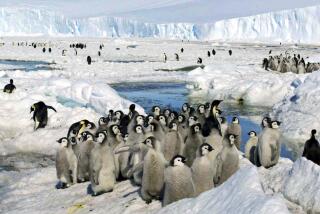Biologists count penguins by satellite
- Share via
Using space technology to sniff out a telltale trail of penguin poop strewn about the edges of Antarctica, scientists have completed the first-ever census of an animal population taken with satellite imagery.
The collaboration of British and American researchers was able to identify 44 emperor penguin colonies, including seven that were previously unknown. They counted 595,000 birds — twice as many as they expected to see.
“Now that we have this baseline information, we can start asking new questions” about the Antarctic ecosystem, said Michelle LaRue, a doctoral student in conservation biology at the University of Minnesota-Twin Cities and coauthor of a paper about the discovery, published Friday in the journal PLoS One.
As depicted in the 2005 film “March of the Penguins,” emperor penguin pairs battle temperatures as low as minus 40 degrees Fahrenheit to nest at their breeding sites each year.
The harsh conditions have made it hard for scientists to measure the size and number of penguin colonies in the past, but the birds’ predictable behavior makes them great candidates for long-term satellite tracking, LaRue said.
Also, emperor penguins are large (about 4 feet tall and 50 to 100 pounds), have dark plumage (which stands out against the ice) and live in a habitat with no trees (which could obstruct the view from a satellite).
LaRue uses a variety of technologies to study animal populations. Peter Fretwell, a geographer with the British Antarctic Survey, contacted her in 2009 to attempt the emperor penguin census.
At first, LaRue said, she didn’t believe it would be possible to see penguins from space. After all, the commercial satellites the team used orbit nearly 300 miles above the Earth.
But by scanning for “little brown stains” of guano — droppings, the birds’ signature mark — and zooming in bit by bit, the researchers were eventually able to spot individual penguins dotting the Antarctic ice.
The team members programmed computers to distinguish between the ice, guano patches and penguins. They measured the total land area that appeared to be covered with birds and used it to estimate how many individuals were there. They also used data from ground counts and aerial photographs to assist with their calculations.
Biologists are concerned that climate change will cause Antarctic sea ice to melt. That could shrink the emperor penguins’ territory and drastically reduce the number of birds, LaRue said. If so, the effects would ripple throughout the entire ecosystem.
“This opens the way for assessing changes underway in the Southern Ocean,” said David Ainley, a marine biologist at the ecological consulting firm H.T. Harvey and Associates in Los Gatos, who was not involved in the study.






